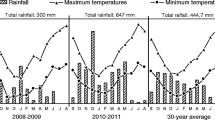Abstract
Zymoseptoria tritici, a globally distributed pathogen, is responsible of Septoria tritici blotch (STB), one of the most damaging wheat diseases. In Italy the incidence of STB has increased during the past few years. The presence of Z. tritici on flag leaves of susceptible durum wheat plants, cultivar San Carlo, after a single artificial inoculation with two inoculum concentrations at different vegetative stages has been evaluated in the plain of Bologna (North of Italy), in a two year field study (2012–2013). The pathogen presence was also assessed in natural infection conditions after a fungicide application in the second year (2013). The results obtained, by visual examination (Incidence, Disease Severity) and DNA quantification by Real time PCR, demonstrated that BBCH 39 (flag leaf stage) is the most susceptible vegetative stage, independently of inoculum concentration and climatic conditions. A good correlation between Disease Severity and DNA quantity was observed in either sampling methods, entire flag leaves and flag leaf discs. Thereafter the most suitable period to obtain the best crop protection with only one fungicide treatment is the flag leaf stage.
Similar content being viewed by others
References
Alkadri, D., Nipoti, P., Döll, K., Karlovsky, P., Prodi, A., Pisi, A. 2013. Study of fungal colonization of wheat kernels in Syria with a focus on Fusarium species. Int. J. Mol. Sci. 14:5938–5951.
Alvisi, G., Cristiani, C., Ponti, D., Betti, C., Ferrari, A. 2014. Grano duro: lotta alla septoriosi, quale strategia di difesa usare. Supplemento Informatore Agrario, “Cereali – difesa e nutrizione”, 9:20–23.
Bronnimann, A. 1968. Investigations of Septoria nodorum Berk. of wheat. Mitt. Schveiz. Landwirt. 16:65–67.
Dean, R., Van Kan, J.A., Pretorius, Z.A., Hammond-Kosack, K.E., Di Pietro, A., Spanu, P.D., Rudd, J.J., Dickman, M., Kahmann, R., Ellis, J. 2012. The Top 10 fungal pathogens in molecular plant pathology. Mol. Plant Path. 13:414–430.
Fones, H., Gurr, S. 2015. The impact of Septoria tritici Blotch disease on wheat: An EU perspective. Fungal Gen. and Biol. 79:3–7.
Fraaije, B., Lovell, D.J., Rohel, E.A., Hollomon D.W. 1999. Rapid detection and diagnosis of Septoria tritici epidemics in wheat using a polymerase chain reaction/Pico green assay. J. Appl. Microbiol. 86:701–708.
Fraaije, B.A., Cools, H.J., Fountaine, J., Lovell, D.J., Motteram, J., West, J.S., Lucas, J.A. 2005. The role of ascospores in further spread of QoI-resistant cytochrome b alleles (G143A) in field populations of Mycosphaerella graminicola. Phytopathol. 95:933–941.
Goudemand, E., Laurent, V., Duchalais, L., Tabib Ghaffary, S.M., Kema, G.H.J., Lonnet, P., Margalé, E., Robert, O. 2013. Association mapping and meta-analysis: two complementary approaches for the detection of reliable Septoria tritici blotch quantitative resistance in bread wheat (Triticum aestivum L.). Mol. Breed. 32:563–584.
Guo, J.R., Schneider, F., Verreet, J.A. 2006. Presymptomatic and quantitative detection of Mycosphaerella graminicola development in wheat using Real Time PCR. FEMS Microbiol. Lett. 262:223–229.
Kema, G.H.J., Verstappen, E.C., Todorova, M., Waalwijk, C. 1996. Successful crosses and molecular tetrad and progeny analyses demonstrate heterothallism in Mycosphaerella graminicola. Curr. Genet. 30:251–258.
Mirzadi Gohari, A., Ware, S.B., Wittenberg, A.H.J., Mehrabi, R., Ben M’Barek, S., Verstappen, E.C.P., van der Lee, T., Robert, O., Schouten, H., de Wit, P., Kema, G. 2015. Effector discovery in the fungal wheat pathogen Zymoseptoria tritici. Mol. Plant Path. 16:931–945.
O’Driscoll, A.O., Kildea, S., Doohan, F., Spink, J., Mullins, E. 2014. The wheat–Septoria conflict: a new front opening up?. Trends Plant Sci. 19:602–610.
Pasquini, M., Iori, A., Nocente, F., Sereni, L., Cacciatori, P., Cristofori, C., Caprara, F., Codianni, P., Licciardello, S., Martelli, M., Notario, T., Petrini, A., Podda, E., Randazzo, B., Viola, P. 2015. Sensibilità dei frumenti alle principali malattie fungine. L’informatore agrario 39:42–46.
Shaw, M.W. 1987. Assessment of upward movement of rain splash using a florescent tracer method and its application to the epidemiology of cereal pathogens. Plant Pathol. 36:201–213.
Shaw, M.W., Royle, D.J. 1993. Factors determining the severity of epidemics of Mycosphaerella graminicola (Septoria tritici) on winter wheat in the UK. Plant Pathol. 42:882–899.
Torriani, S.F.F., Brunner, P.C., McDonald, B.A., Sierotzki, H. 2009. QoI resistance emerged independently at east 4 times in European populations of Mycosphaerella graminicola. Pest Manag. Scie. 65:155–162.
Torriani, S., Melichar, J., Mills, C., Pain, N., Sierotzki, H. 2015. Zymoseptoria tritici: A major threat to wheat production, integrated approaches to control. Fungal Gen. and Biol. 79:8–12.
Author information
Authors and Affiliations
Corresponding author
Additional information
Communicated by M. Taylor
Rights and permissions
About this article
Cite this article
Tonti, S., Alvisi, G., Pisi, A. et al. DNA Quantification to Assess Zymoseptoria tritici on a Susceptible Cultivar of Durum Wheat to Establish the Best Timing for Fungicide Application in an Italian Environment. CEREAL RESEARCH COMMUNICATIONS 47, 304–313 (2019). https://doi.org/10.1556/0806.47.2019.03
Received:
Accepted:
Published:
Issue Date:
DOI: https://doi.org/10.1556/0806.47.2019.03




